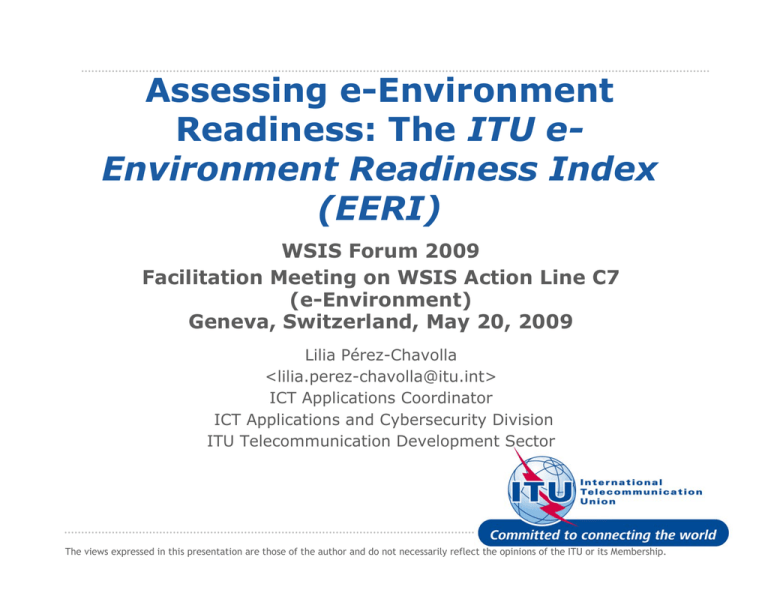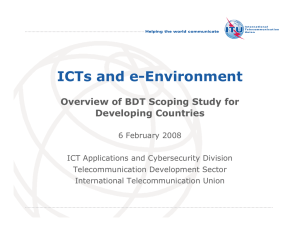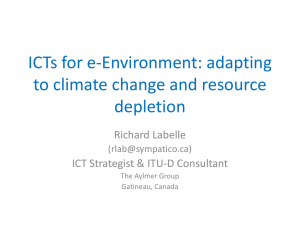Assessing e-Environment ITU e- Environment Readiness Index (EERI)
advertisement

Assessing e-Environment Readiness: The ITU eEnvironment Readiness Index (EERI) WSIS Forum 2009 Facilitation Meeting on WSIS Action Line C7 (e-Environment) Geneva, Switzerland, May 20, 2009 Lilia Pérez-Chavolla <lilia.perez-chavolla@itu.int> ICT Applications Coordinator ICT Applications and Cybersecurity Division ITU Telecommunication Development Sector International Telecommunication Union The views expressed in this presentation are those of the author and do not necessarily reflect the opinions of the ITU or its Membership. ITU Work on e-Environment ITU mandate on ICT applications and strategies: ¾ Co-facilitator of WSIS Action Line C7 on e-Environment ¾ Develop guidelines, training materials and toolkits on technology & policy aspects of e-Environment applications ¾ Assist developing countries in implementing relevant ICT applications for environment and sustainable development Mandate: Resolution 35, ITU Plenipotentiary Conference (Kyoto, 1994) & Resolution 54, ITU World Telecommunication Development Conference (Doha, 2006) 2 ICTs for e-Environment Report Objective: ¾ Provide guidelines for developing countries on the use of ICTs for better management and protection of the environment as a key part of their development process, with particular focus on climate change Examines six areas of ICT use: ¾ Environmental Observation ¾ Analysis ¾ Planning ¾ Management and Protection ¾ ICT Mitigation and ¾ Capacity Building http://www.itu.int/ITU-D/cyb 3 Current ITU-D Activities To assist decision-makers in ITU Members States, ITU-D has initiated a series of activities: ¾ E-Environment toolkit: Practical guidelines for assessing needs and establishing strategies for the implementation of national e-environment plans ¾ Capacity building: Joint training with the Abdus Salam International Centre for Theoretical Physics (ICTP) 44 E-Environment Toolkit Currently being finalized Practical tool for rapid assessment of a country’s potential for using ICTs to help mitigate and adapt to environmental change Identifies key indicators reflecting country readiness to use ICTs for fighting environmental change Conceived as part of a comprehensive esustainability strategy 5 ¾ ¾ ¾ ¾ Components of the e-Environment Toolkit The Toolkit will include: A list of first tier and secondary indicators The e-Environment Readiness Index (EERI): Methodology and calculations for assessing e-environment readiness Guidance for developing an esustainability strategy Online and other resources regarding e-environment indicators 6 The EERI The EERI is a composite index of factors that contribute to e-Environment readiness at a country level Is a relative measure of potential contributions, both positive and negative, that ICTs make to: ¾ GHG emissions ¾ Energy use ¾ Waste reduction ¾ The conservation of the environment and of natural resources Is a relative number (score), computed using a select number of published indicators available in a time series (first tier indicators) Structure of the EERI Tiered structure: ¾ ICT Indicators (Infrastructure, use of ICTs for e-environment, ICT applications, energy quality, human capacity) ¾ Environmental indicators (Biodiversity, GHG emissions, long-term preparedness, policy and public awareness) ¾ First level EERI (composite result) Example of indicators and data sources ICT Infrastructure indicators: ¾ Total number of telephone subscribers (fixed + mobile) per 100 inhabitants ¾ Broadband subscribers per 100 inhabitants ¾ Internet users per 100 inhabitants ¾ International Internet bandwidth per inhabitant (bits/s) Source: ITU Example of indicators and data sources (cont.) ICT Applications: ¾Network Readiness Index (NRI) ¾e-Government readiness index ¾Number of secure servers as a measure of the extent of e-commerce Sources: World Economic Forum, UNPAN/DESA, SSL Servers EERI’s Indicator Selection The proposed first level indicators have been selected according to the following criteria: ¾ Ease of access ¾ Global coverage ¾ Frequently updated ¾ Numerical, or standardized range of values ¾ Relevance to the specific segment of the EERI Methodology Each of the two tiers is normalized on a scale of zero to ten 10= best-in-class or worst-in-class performance (for negative indicators such as GHG emissions) in relation to that segment of indicators Weighting is associated with each indicator according to the relative number of indicators in that segment In addition, weighting is balanced between the ICT and Environmental segments This methodology permits both assessment and prioritization of the areas that are most lacking Sample of EERI Country Results First Level EERI Normalized ICT Summary Indicator Applications e-Environment Energy Quality Human Capacity Infrastructure Normalized Environmental Summary Indicator Biodiversity Green-house gases Long-term preparedness Policy & Public Awareness Mongolia Ethiopia Chad Kyrgyzstan Chile Guatemala Trinidad and Tobago Sweden Canada Korea, Republic of 4.6 4.0 3.4 4.3 6.5 5.6 7.1 7.9 7.1 6.7 3.0 2.3 1.4 3.5 5.9 3.8 5.3 8.5 8.4 7.7 4.0 1.4 1.1 3.0 6.1 4.4 4.7 9.3 8.8 8.6 3.1 4.7 3.1 4.7 8.4 4.7 4.7 8.4 10.0 8.4 2.6 3.7 ... 2.2 5.1 4.7 7.9 7.7 7.5 5.9 3.6 0.9 ... 6.0 5.0 2.0 3.6 9.5 7.6 7.8 1.9 0.4 0.0 1.7 4.9 3.2 5.0 7.5 8.4 7.9 6.2 5.6 5.4 5.0 7.2 7.3 8.9 7.4 5.7 5.8 3.5 4.4 2.3 0.8 4.7 8.2 9.7 1.8 2.1 1.1 8.7 10.0 10.0 9.6 8.5 9.6 10.0 7.9 2.0 6.1 6.4 5.9 6.6 4.3 7.4 7.3 7.8 8.3 8.2 6.6 5.7 1.2 0.0 5.7 7.5 4.1 9.9 10.0 7.5 8.3 Interpreting the EERI Interpretation should be performed at all three levels of the tiered indicators, in order to identify: ¾ Country weaknesses or strengths ¾ Specific areas that can be tackled to create gains in either the ICT or environment domains ¾ Areas of specific interest that can be isolated and analyzed further The EERI results can facilitate also ¾ Multi-year analysis to identify trends ¾ Cross-comparison with other countries Next Steps Circulate the Toolkit draft report and the EERI and obtain feedback Support developing countries in conducting e-Environment readiness assessments Aid selected countries in developing eEnvironment strategies and action plans, in collaboration with partners (see Annex) Monitor and evaluate results Share best practices with other countries 15 More Information ITU Climate Change ¾ www.itu.int/themes/climate/ ITU-D e-Environment home page ¾ www.itu.int/ITU-D/cyb/app/e-env.html 16 International Telecommunication Union Committed to connecting the world 17

